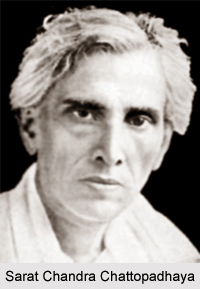 Steeped in the mutinous political scenario of 20th century, Bipradas is the tale of a majestic fortitude of a benevolent zamindar, stationed in rural vicinity. Bipradas represents the generosity of an administrator, unlike the so-called zamindars of the contemporary era. In the socio-political context of 20th century Bengal, the novel Bipradas presents a super human soul. In spite of being ingrained with the traditional ethico-moral customs, observed in an orthodox Hindu family, Bipradas epitomized the sophistication of an ideal hero, suitable for the eradication of social indiscrimination, which is the immediate outcome of the prevailing socio-political outlook.
Steeped in the mutinous political scenario of 20th century, Bipradas is the tale of a majestic fortitude of a benevolent zamindar, stationed in rural vicinity. Bipradas represents the generosity of an administrator, unlike the so-called zamindars of the contemporary era. In the socio-political context of 20th century Bengal, the novel Bipradas presents a super human soul. In spite of being ingrained with the traditional ethico-moral customs, observed in an orthodox Hindu family, Bipradas epitomized the sophistication of an ideal hero, suitable for the eradication of social indiscrimination, which is the immediate outcome of the prevailing socio-political outlook.
Author: - Sarat Chandra Chattopadhya, born in 15th September 1876, was one of the renowned stalwarts of the Bengal Literary world. The novelist in the robe of a social reformer, with the power of his pen brings to surface the social problems, which are the reasons behind the political oppression. Born in a rural family Sarat Chandra was familiar with the conventions followed in an orthodox Brahmin family. The political disturbances, which influenced the youngsters of Bengal, were also the theme of his novels. Essentially a social reformer Sarat Chandra Chattopadhya, in his social novels invested the political backdrop, which made his novels utterly precious as socio-political documents.
Synopsis: - Set in a rural backdrop of tumultuous, 20th century milieu, Bipradas is a novel, representing a man of high moral values and resilient determination. The zamindar of the village, Bipradas who himself is a stepson of the zamindar family is the key force behind the family and his very dear to his stepmother. Besides being a zamindar, he also maintains the family business in Kolkata. The story line develops with the life and activities of the protagonist Bipradas. Bipradas, the zamindar induced social reforms in the native village in order to educate people and enlighten them to liberate themselves fro socio-political repressions. Instead of being a participant in radical politics, he was the exemplar of the victor, who visualized the core problem of illiteracy and poverty as the sole reason behind the predicament of contemporary society and nation. He merely supported his younger brother, who was an impulsive extremist out of love, even knowing the fact that the radicalism and his brother`s endeavor ultimately will yield nothing.
Under the scaffold of a political background, developed a social story involving the family life of Bipradas, which is the revolving force of the novel. The family institution of Bipradas came on the verge of destruction, when to save her sister, he transferred all his property in her name and finally was forced to leave the family by the evil design of his brother in law. Thus the zamindar family was completely shattered. But Bipradas, the charismatic hero of the novel, without submitting to the ways of destiny left his ancestral home, with his family. The departure of Bipradas, bring, Dwijadas to manage all the zamindary including family. However, something different was preordained for the zamindary family and Bipradas, losing his wife came back to his native land. Within this troubled socio-political condition developed the amorous relationship between Dwijadas and Bandana, a close relative of the zamindar family and English educated girl, which finds expression in their marriage. The story concludes with Bipradas deserting the family with his mother Kironmoyee for endless journey, leaving the entire zamindary, family and his son Bashu to Bandana and Dwijadas.
The didactic novel, Bipradas, is the replica of the family institution, entrenched in the political background of Indian struggle for Independence. The title truly signifies the fundamental spirit of the novel depicting Bipradas as a modern Renaissance man in his majestic fortitude and benevolence.
Bipradas, the celebrated novel for all ages, originally appeared min Benu, a magazine published by the Bengal volunteers a group of political revolutionaries founded by Hem Chandra Ghosh. After the publication of 9 chapters, the publication of Benu was stopped owing to the resurgence of the writer`s building Battle in which famous Binoy-Badal-Dinesh died and others were imprisoned. Serially the novel completely published in Bichitra, a magazine. The novel first appeared as a book on 1st February 1935 by GCS publication.













